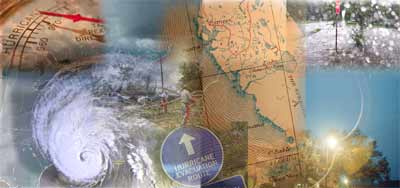Hurricane Season Approaches

Hurricane season is upon us again, even though some areas of the District haven’t even finished clearing away the debris from last season’s devastating series of storms.
The 2004 Atlantic hurricane season produced 15 tropical storms and 9 hurricanes, 6 of which were major hurricanes. Florida experienced widespread damage from four of the majors — Charley, Frances, Ivan and Jeanne. A major hurricane is classified as a category 3, 4 or 5.
Dr. William Gray, a hurricane expert from Colorado State University, says the 2005 Atlantic hurricane season could also be active. Gray predicts 11 tropical storms and 6 named hurricanes, 3 of them being major hurricanes.
Meanwhile, the District is still “feeling the effects” of the 2004 hurricane season from an administrative standpoint. The District spent vast amounts of time and money preparing for and working during and after the storms. In fact, from August through January, District staff logged more than 14,300 regular and 7,669 overtime hours on hurricane-related activities, totaling $441,865 in salary and benefits.
After Hurricane Charley, the District’s Governing Board approved $1.2 million to clean up debris in the Peace Creek Drainage Canal.
The Peace Creek cleanup project is part of the Districtwide debris removal effort being cooperatively funded by the District and Natural Resources Conservation Service (NRCS). The total cost is just under $8 million, with approximately 75 percent being reimbursed by NRCS. District staff is currently working on securing contracts with qualified contractors to complete the remainder of the debris removal projects.
Other costs associated with hurricane recovery are still being tabulated.
“Hurricane season really tested our staff, but we learned that they are a very well-trained, well-organized group who know how to respond to emergency conditions,” said Gary Kuhl, operations director.
The District coordinated its efforts with the state’s Emergency Operations Center to quickly mobilize staff and equipment to assist other government entities in some of the hardest-hit areas like Charlotte, DeSoto, Hardee and Polk counties.
In addition to an increase in staff time, the District also designated funding for cleanup projects, studies, upgrades to flood control and water conservation facilities, and other projects and equipment associated with last year’s storms, or to help prepare for future storms.
District staff also learned several valuable lessons to be better prepared this season.
The biggest challenge staff faced during the hurricanes was the potential for flooding and how to manage the flood control and water conservation structures to prevent or minimize flooding. After the hurricanes passed, the challenge was mobilizing and coordinating field staff to assist counties and cities most affected.
More than 20 District structures are operated by remote control equipment, which means staff can safely and quickly open gates during a storm or other emergency. However, the need to improve alternative power supply sources for the major flood control structures, like the Tampa Bypass Canal (TBC), is being addressed. During 2004, some structures on the TBC had to be operated manually when power was not available.
Other areas being evaluated include structure improvements and equipment needs. The District is reviewing the need to upgrade its Emergency Operations Center and computer facilities so they can withstand stronger winds. District plans include being able to provide uninterrupted power sources at the service offices and having alternative office facilities available in case critical facilities are damaged or destroyed. The District purchased four satellite phones and a half dozen more powerful cell phones because staff experienced communication problems in remote areas after Hurricane Charley. Two-way radio systems are being considered in the fiscal year 2006 budget.
The District is also working on improving some of its internal procedures. For instance, the District is planning to develop outside contracts for standby services, such as debris removal, that can be activated when needed. Also, the District is considering an improved system to notify employees about emergencies or closures.
“All in all, the District performed well, and learned some very positive things regarding our abilities to cope with emergencies,” said Kuhl. “And we believe the improvements we will make from the lessons we learned will allow us to be even more prepared to help the public in future emergency situations.”
